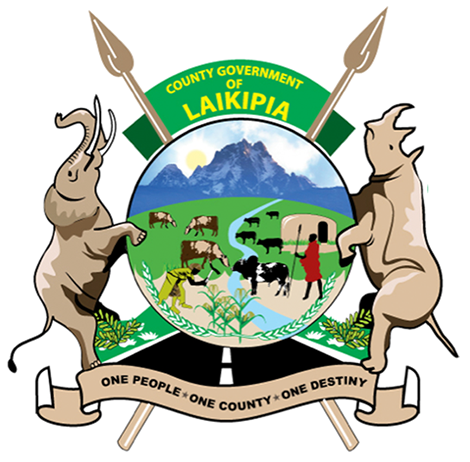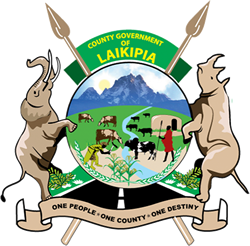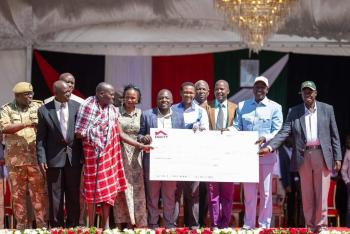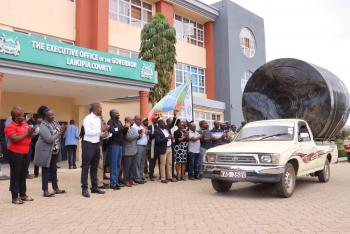Living In Laikipia
Updated on: Nov 12, 2018
Laikipia County is one of the 14 counties within the Rift Valley region and one of the 47 counties in the Republic of Kenya. It borders Samburu County to the North, Isiolo County to the North East, Meru County to the East, Nyeri County to the South East, Nyandarua County and Nakuru County to the South West and Baringo County to the West. It covers an area of 9,462 km2 and is ranked as the15th largest county in the country by land size.
The county is occupied by a mixture of communities from almost every part of Kenya; however, the majority of the population is made up of Kikuyu, Kalenjin, Turkana, Meru, Samburu, Boran, etc. The rest of the population is made up of the pastoral Mukogodo, Maasai and the Dorobo. A small percentage of the non-African population is Asian traders and a remnant of white settlers who are mostly ranchers. The African population moved into the county after the exit of the white settlers who had dominated the economy since the onset of colonization and up to the time Kenya became an independent nation. The settlers' mode of agriculture during their occupation was plantation type of farming and ranching on large well managed farms. These were maintained through a labor force obtained from neighboring counties especially Nyeri. This approach along with subsidized extension services from the colonies' coffers made Laikipia a major producer of beef, dairy products, and cereals.
According to the 2009 KNBS Housing and Population Census, the total population for the county stood at 399,227 people of which 198,625 were males and 200,602 were females. This population was projected increase to 427, 173 persons in 2012 and rise to 457,514 and 491, 927 in 2015 and 2018 respectively.
The settlement patterns in the county are uneven as they are influenced by varying land potential, livelihood zones, infrastructure access, land use system and availability of social amenities. Laikipia North constituency is arid and semi-arid in nature and therefore the least populated arising from wild life ranches and pastoral livelihood patterns. Laikipia West and Laikipia East have the highest population densities attributed to medium towns namely Nyahururu and Nanyuki. These towns are the commercial, administrative and transportation hubs of the county.
Additional Information on Living in Laikipia
The British Army has been training in Kenya since 1964 when the Kenyan and British governments signed off a memorandum of understanding. BATUKS training area stretches from Laikipia to Samburu Counties and covers a wide range of climatic conditions from arid savannah to upland forest. Since the wars in Afghanistan and Iraq began, Kenyas training grounds have become increasingly relevant to the British Army because of the great similarities in climatic conditions (hot in the day and cool in the night) and the terrain (hilly, open spaces and high altitude.
Mpala Ranch in Laikipia, Kenya became their first training ground. Over the years Ol Doinyo Lemboro, Loldaiga and 01 Naishu ranches were added to the list of hosting ranches. In 2009 BATUK expanded these grounds to 11 privately owned ranches, including Sosian, Ol Maisor and the Laikipia Nature Conservancy. BATUK provides substantial benefits at the national and local levels. At the national level the government of Kenya receives annual revenues and intensive training of her armed forces. At the local level, ranch owners, lodge owners, traders, and residents who are employed on permanent and casual basis (about 900 People in total) benefit significantly from BATUK expenditure in wages, salaries, food contracts, vehicle hire, building works, and the regular grading and maintenance of roads and bridges.
Infrastructural development projects include the construction of schools, clinics and police posts. Sartain, R. P. (2010). British Army in Laikipia and Samburu, in Laikipia Wildlife Forum Newsletter, January 2010, estimates that direct financial input in these expenditures go well over £ 17 million (about Ksh. 2.323 billion) annually; besides personal soldier expenditures on goods and services. Documented wildlife-based tourism revenue in Laikipia amounted to $ 20.5 million (about Ksh. 1.7 billion) in 2007, (Laikipia Wildlife Forum, undated, unpublished report). Laikipia landowners and residents as a whole may be getting more money from BATUK than from wildlife based tourism as revealed from these financial reports.
Lured by good weather that prevails all year round, game in the nearby conservancies and expansive parks among attractions in Laikipia, Europeans particularly the British are either settling in the county or buying holiday homes around Nanyuki and Nyahururu towns. Most of the white settlers buying up property are soldiers or tourists who loved the countys climate, its people and natural beauty and want to experience it all over again.
Big time investors in real estate flock to the area, either to buy or construct multi-million shilling holiday homes, targeting wealthy European settlers and tourists, a modern concept that is shaking the real estate industry. Built on rustic, glamorous natural features such as mountains, wilderness and water bodies, holiday options in Laikipia have diversified and expanded; with some developers giving investors property with controlled access to wildlife as well as other amenities such as golf courses, sweetening up the home life while still maintaining the addictive picturesque beauty of the natural landscapes.
One such company is Swiss international which entered a 7 billion pact with Mount Kenya Holiday homes to develop and manage a 75 suite hotel, two restaurants, a bar and lounge, villa spa among others. Buyers of the homes will therefore own homes on a five star resort with the 281 homes consisting of 67 villas, 128 apartments and 86 townhouses. Additionally, the development includes a conserved natural-forest area hosting a variety of wildlife that include; Zebras and Gazelles among other animals. Other holiday homes in the region include Mukima House, Nearmount Kenya Holiday Homes, Kiota Safari Homes, Comfort Gardens Cottage, Madison House, Batian Apartment, and Pelican House.
The county has over the past decade witnessed rapid urbanization due to emergence of many horticultural farms, new tourist attraction sites, rural-urban migration and migration from neighboring counties, commercial ranching and setting up of military bases including the British Training Unit in Kenya (BATUK). The preference of settling in urban centers underlines the need to have organized, better-managed and people-friendly urban centers.
The county is occupied by a mixture of communities from almost every part of Kenya; however, the majority of the population is made up of Kikuyu, Kalenjin, Turkana, Meru, Samburu, Boran, etc. The rest of the population is made up of the pastoral Mukogodo, Maasai and the Dorobo. A small percentage of the non-African population is Asian traders and a remnant of white settlers who are mostly ranchers. The African population moved into the county after the exit of the white settlers who had dominated the economy since the onset of colonization and up to the time Kenya became an independent nation. The settlers' mode of agriculture during their occupation was plantation type of farming and ranching on large well managed farms. These were maintained through a labor force obtained from neighboring counties especially Nyeri. This approach along with subsidized extension services from the colonies' coffers made Laikipia a major producer of beef, dairy products, and cereals.
According to the 2009 KNBS Housing and Population Census, the total population for the county stood at 399,227 people of which 198,625 were males and 200,602 were females. This population was projected increase to 427, 173 persons in 2012 and rise to 457,514 and 491, 927 in 2015 and 2018 respectively.
The settlement patterns in the county are uneven as they are influenced by varying land potential, livelihood zones, infrastructure access, land use system and availability of social amenities. Laikipia North constituency is arid and semi-arid in nature and therefore the least populated arising from wild life ranches and pastoral livelihood patterns. Laikipia West and Laikipia East have the highest population densities attributed to medium towns namely Nyahururu and Nanyuki. These towns are the commercial, administrative and transportation hubs of the county.
Additional Information on Living in Laikipia
The British Army has been training in Kenya since 1964 when the Kenyan and British governments signed off a memorandum of understanding. BATUKS training area stretches from Laikipia to Samburu Counties and covers a wide range of climatic conditions from arid savannah to upland forest. Since the wars in Afghanistan and Iraq began, Kenyas training grounds have become increasingly relevant to the British Army because of the great similarities in climatic conditions (hot in the day and cool in the night) and the terrain (hilly, open spaces and high altitude.
Mpala Ranch in Laikipia, Kenya became their first training ground. Over the years Ol Doinyo Lemboro, Loldaiga and 01 Naishu ranches were added to the list of hosting ranches. In 2009 BATUK expanded these grounds to 11 privately owned ranches, including Sosian, Ol Maisor and the Laikipia Nature Conservancy. BATUK provides substantial benefits at the national and local levels. At the national level the government of Kenya receives annual revenues and intensive training of her armed forces. At the local level, ranch owners, lodge owners, traders, and residents who are employed on permanent and casual basis (about 900 People in total) benefit significantly from BATUK expenditure in wages, salaries, food contracts, vehicle hire, building works, and the regular grading and maintenance of roads and bridges.
Infrastructural development projects include the construction of schools, clinics and police posts. Sartain, R. P. (2010). British Army in Laikipia and Samburu, in Laikipia Wildlife Forum Newsletter, January 2010, estimates that direct financial input in these expenditures go well over £ 17 million (about Ksh. 2.323 billion) annually; besides personal soldier expenditures on goods and services. Documented wildlife-based tourism revenue in Laikipia amounted to $ 20.5 million (about Ksh. 1.7 billion) in 2007, (Laikipia Wildlife Forum, undated, unpublished report). Laikipia landowners and residents as a whole may be getting more money from BATUK than from wildlife based tourism as revealed from these financial reports.
Lured by good weather that prevails all year round, game in the nearby conservancies and expansive parks among attractions in Laikipia, Europeans particularly the British are either settling in the county or buying holiday homes around Nanyuki and Nyahururu towns. Most of the white settlers buying up property are soldiers or tourists who loved the countys climate, its people and natural beauty and want to experience it all over again.
Big time investors in real estate flock to the area, either to buy or construct multi-million shilling holiday homes, targeting wealthy European settlers and tourists, a modern concept that is shaking the real estate industry. Built on rustic, glamorous natural features such as mountains, wilderness and water bodies, holiday options in Laikipia have diversified and expanded; with some developers giving investors property with controlled access to wildlife as well as other amenities such as golf courses, sweetening up the home life while still maintaining the addictive picturesque beauty of the natural landscapes.
One such company is Swiss international which entered a 7 billion pact with Mount Kenya Holiday homes to develop and manage a 75 suite hotel, two restaurants, a bar and lounge, villa spa among others. Buyers of the homes will therefore own homes on a five star resort with the 281 homes consisting of 67 villas, 128 apartments and 86 townhouses. Additionally, the development includes a conserved natural-forest area hosting a variety of wildlife that include; Zebras and Gazelles among other animals. Other holiday homes in the region include Mukima House, Nearmount Kenya Holiday Homes, Kiota Safari Homes, Comfort Gardens Cottage, Madison House, Batian Apartment, and Pelican House.
The county has over the past decade witnessed rapid urbanization due to emergence of many horticultural farms, new tourist attraction sites, rural-urban migration and migration from neighboring counties, commercial ranching and setting up of military bases including the British Training Unit in Kenya (BATUK). The preference of settling in urban centers underlines the need to have organized, better-managed and people-friendly urban centers.



